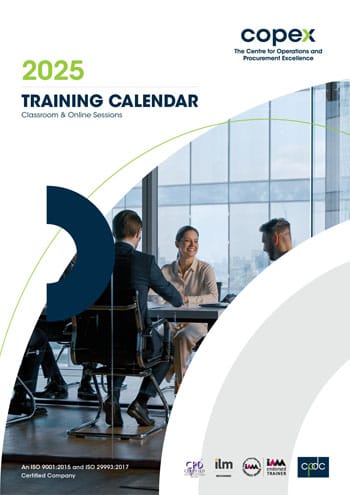
Negotiation Tactics Used by Effective Procurement Professionals
4 mins readHow Strategic Negotiators Secure Value, Mitigate Risk, and Strengthen Supplier Relationships
Negotiation is not a single event—it’s an ongoing strategic activity. The most effective procurement professionals understand that securing favorable terms goes beyond price. It’s about value creation, risk mitigation, relationship building, and long-term supplier performance.
This article explores the most effective negotiation tactics used by procurement professionals, drawing on proven practices and behavioral techniques that lead to sustainable outcomes. Whether you’re managing tenders, renegotiating contracts, or dealing with sole-source suppliers, mastering these tactics is essential for success. You’ll also find links to advanced professional development options such as the Tendering, Procurement & Negotiation Skills Course, Effective Negotiation, Persuasion & Critical Thinking Course, Strategy, Risks, Negotiation & Leadership Course, Engaging Negotiation Dynamics to Achieve Sustainable Outcomes Course and Certified Negotiation Strategist Course.
Why Procurement Negotiation Is Different
Negotiating in procurement is fundamentally different from general business negotiations. Procurement professionals face unique variables such as:
- Multi-year contracts
- Supply continuity risks
- Changing commodity markets
- Legal compliance obligations
- Supplier performance management
- Stakeholder expectations across departments
As such, procurement negotiation requires a balance of technical knowledge, commercial acumen, and interpersonal skill.
Tactical Preparation: The Foundation of Success
Before engaging a supplier, effective negotiators prepare extensively. Preparation is not just about studying supplier quotes—it’s about understanding the full landscape.
Preparation Tactics Include:
- Total cost of ownership analysis
- Supplier research and risk profiling
- BATNA identification (Best Alternative to a Negotiated Agreement)
- Contract term benchmarking
- Internal alignment with stakeholders
The Tendering, Procurement & Negotiation Skills Course provides procurement professionals with structured tools to prepare for complex negotiation scenarios and ensure alignment with broader supply chain strategy.
Building Leverage Without Being Aggressive
Leverage is key in any negotiation, but in procurement, it must be wielded with care. Overly aggressive tactics may lead to short-term wins but long-term supplier disengagement.
Effective Ways to Build Leverage:
- Aggregate spend to secure better pricing
- Present competitive alternatives (even if limited)
- Offer volume or contract length in exchange for better terms
- Leverage data from supplier scorecards or audits
- Use timing to your advantage (e.g., end-of-quarter discussions)
Understanding the psychology behind influence and timing is a focus area of the Effective Negotiation, Persuasion & Critical Thinking Course, which blends logical frameworks with behavioral insight.
Strategic Use of Silence and Listening
One of the most underutilized tactics in procurement negotiation is silence. Too often, professionals rush to fill the gap. Silence forces the other party to respond—often with concessions or additional information.
Active listening helps to:
- Detect supplier constraints
- Uncover hidden opportunities
- Understand what the supplier values
- Build rapport and trust
The Engaging Negotiation Dynamics to Achieve Sustainable Outcomes Course emphasizes emotional intelligence and active listening as key skills for uncovering supplier motivators.
Anchoring and Framing Techniques
Framing is how you position your opening statement. Anchoring involves setting the first reference point in a discussion, which can have a disproportionate influence on the final agreement.
Examples of Anchoring in Procurement:
- Starting with a lower-than-expected price to anchor the discussion
- Framing terms as “industry standard” to justify your position
- Offering multiple options to control how the negotiation unfolds
Procurement professionals learn to use these tactics ethically and strategically in the Certified Negotiation Strategist Course, which develops high-level influencing techniques across international negotiations.
Managing Stakeholders During Negotiation
Procurement negotiation often involves internal stakeholders with varying priorities—finance, operations, legal, and more. Balancing these voices requires a separate set of tactics:
- Align objectives early and document them
- Use data to support your negotiation stance
- Communicate trade-offs and outcomes transparently
- Avoid last-minute changes to the scope or goals
Strategic internal alignment is central to the Strategy, Risks, Negotiation & Leadership Course, which teaches negotiation as a leadership function—not just a procurement task.
Collaborative vs. Competitive Negotiation in Procurement
Both styles have their place in procurement:
|
Collaborative Approach |
Competitive Approach |
|
Long-term supplier relationship |
One-time or transactional negotiation |
|
Focused on value creation |
Focused on cost reduction |
|
Open communication |
Information withholding |
|
Shared risk |
Shifted risk to supplier |
Procurement professionals must evaluate when to use each based on the supplier type, contract value, and organizational goals. The Value-Based Leadership: Engaging Negotiation Dynamics to Achieve Sustainable Outcomes Course trains professionals to lead with integrity while still protecting commercial interests.
Using Multi-Issue Negotiation for Better Trade-Offs
Negotiating on multiple issues—price, lead time, service levels, payment terms—allows you to:
- Package concessions for better overall outcomes
- Trade low-priority items for high-priority wins
- Expand the zone of possible agreement
Multi-issue negotiation increases flexibility and creates win-win scenarios. This technique is particularly relevant in complex sourcing contracts.
Negotiating with Difficult or Sole Suppliers
Sometimes, procurement professionals face limited sourcing options due to IP restrictions, niche materials, or geopolitical issues. In these cases:
- Build rapport with the supplier’s account team
- Seek non-monetary value (e.g., faster delivery, extended warranty)
- Use third-party data to validate your ask
- Look at long-term incentives, not just short-term wins
Even in constrained scenarios, negotiation is possible with creative thinking and patience—core skills developed in the Engaging Negotiation Dynamics to Achieve Sustainable Outcomes Course.
Post-Negotiation Tactics: The Forgotten Phase
Once the deal is done, your role as a negotiator continues:
- Ensure the contract reflects all agreed terms
- Monitor supplier compliance and performance
- Keep communication lines open for future renegotiation
- Document lessons learned for future improvements
Effective procurement professionals view negotiation as a lifecycle—not an event.
Developing a Negotiation Playbook
Many leading procurement teams develop internal playbooks to drive consistency and excellence across negotiations. A negotiation playbook typically includes:
- Pre-negotiation checklist
- Key supplier data points
- Standard contract clauses
- Concession planning templates
- Issue-resolution protocols
- Lessons from past negotiations
This structured approach ensures readiness, reduces risk, and improves outcomes—especially for global teams managing large-scale sourcing events.
Final Thoughts: Elevating Procurement Through Tactical Negotiation
Procurement professionals sit at the crossroads of cost, quality, compliance, and innovation. The ability to negotiate effectively determines not only supplier terms—but business success.
To gain an edge in today’s competitive landscape, professionals should consider formal training through programs such as:
- Tendering, Procurement & Negotiation Skills Course
- Effective Negotiation, Persuasion & Critical Thinking Course
- Strategy, Risks, Negotiation & Leadership Course
- Engaging Negotiation Dynamics to Achieve Sustainable Outcomes Course
- Certified Negotiation Strategist Course
- Value-Based Leadership: Engaging Negotiation Dynamics to Achieve Sustainable Outcomes Course
Each course is designed to strengthen your negotiation strategy, communication, and leadership—essential capabilities for today’s procurement professionals.




